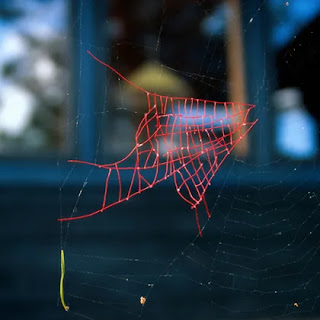Exhale II, 2020
"We live in a world where we are constantly on. There is such a benefit to just slowing down and being quiet. Taking time and focus to look inwards, to sit and breathe quietly, to meditate, to contemplate. There's a real power in reclaiming time for yourself." - Zara Hussain.
I had been inspired by Guiseppe Penone's Breath sculpture series to create my Sospiri (Sigh), series of collages (here), based on breath-work during meditations, and breathing as a tool for health and wellbeing. Having previously seen Zara Hussain's paintings online on this theme during lockdown in an exhibition in America, I felt it would have been remiss of me not to have visited these same paintings in the flesh in this exhibition at the Grosvenor Gallery in St James's. I was intrigued to see how another artist took on, and tackled the subject of breath, and the process of breathing in their own work. I enjoyed seeing the divergent responses on the subject of both Penone, and Hussain to my own. Whilst Penone chose to create something very physical and solid in his response, stating - "When we breathe, there's a volume of air that goes back into space, which is different from the volume of air around us, and that volume of air is a sculpture that lasts an instant, but is already a sculpture." I wanted my response to the theme to be as light, and seemingly intangible as possible. I took Elgar's piece of music Sospiri as an "inspiration" working in white on white with the sparing use of either gold leaf, or siver leaf butterflies to hint at the controlling/calming physical aspect of the inhalation/exhalation process of breath (here). Zarah Hussain goes in for the full chromatic experience in her responses, using the vibrant, saturated colour spectrum. The colours appears vivid when viewed online on a computer screen, but pales in comparison when one is confronted in the actual with these paintings which seem to induce an almost psychedelic visual effect in the viewer, as the paintings appear to vibrate and pulsate with colour when placed next to one another reflecting the Inhalation/exhalation motion of the breathing process. I felt there were similarities in the approaches to Hussain and myself as both sets of outcomes were based on pattern and geometry, but breathing processes apart, similarities in artwork outcomes end there. Hussain's colourful responses were prompted in lockdown by an operation she had to correct her breathing. Hussain states -"I started painting literally at the kitchen table with paper and acrylic paint and expanding on the series that I started earlier on due to my illness. I could identify with what people were going through at that moment with COVID-19. It's only when something comes along like this disease where you can't breathe anymore and you realise how fundamental and essential the simple act of breathing is essential to your life. In a way, making the Breath paintings and having this time to create this body of work helped to have focus. The paintings symbolize the act of breathing. I spoke to a respiratory specialist in a hospital about his job. His work was mainly helping people learn how to breathe without medical intervention. I also spoke to somebody in Salem who'd given birth during the pandemic and how it was to be doing those breathing exercises, but also doing it in the midst of a pandemic wherein another wing of the hospital you've got this disease going through. It was really interesting to talk to those that had gone through those specific experiences and meld that with my work. The perfect breath is about five seconds. Straight away, that gives you a number you can work with. I see things mathematically, and so for me, these paintings were a visual interpretation of what it would look like to breathe in and to breathe out. As an artist, one of the things that I find fascinating is repetition. How numbers repeat and how things in our life go through cycles. Over the day, we breathe in 13,500 times. There is definitely a connection between the body and the way we live in the world. I've been doing quite a lot of research on the breath. The first civilizations that started to look at breath in a really profound way were the Chinese. It's expressed as the word chi. In the Indian civilization, it's called prana. They see breath as a life force that gives you vitality, keeps you alive. There were only six paintings in this exhibition but they were so powerful as a group/pairs reflecting the breathing process, and resonated so strongly with ideas in my own work. These paintings as well as the sculptures of Guiseppe Penone - my original "inspiration" gave my work on breath, a real sense of validation. One of Hussain's Breath paintings can be seen in the current Royal Academy Summer exhibition.
Inhale II , 2020






















































